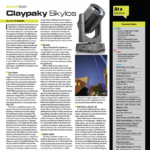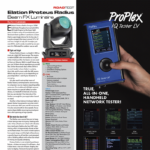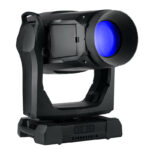Last fall at LDI, I was privileged to walk past the Lightwave International booth and see their new fixture, the Phenom, a moving-head RGB laser that combines the best parts of a moving head fixture with the power and visuals of a laser, offering LDs a brand new, previously-unseen effect for their toolkit.
Construction
The unit’s exterior housing is clearly built with a utilitarian design philosophy — it’s blocky and angular, with a base housing the power supply and pan motors and a moving head housing the laser systems. The arm construction is plastic and the rest of the light is housed inside anodized aluminum and powder-coated steel for durability. Laser diodes, like LEDs, are very temperature sensitive, so a large heat sink is mounted to the head and the light has an internal heating block. At full draw, with the heater, the unit pulls 1.6A at 220V, or around 3.3A at 110V. These figures drop when the heating block isn’t required. The cooling fans are moderately noisy, but I do not expect this will be an issue for the light’s intended users.
Safety
Lasers are well known as devices that should not be directed into people’s eyes, and the regulation of concert laser systems is (rightfully) extremely stringent. Here, however, the device has been manufactured from the ground up to be intrinsically safe while scanning the eyes of audience members. The safety system acts as a “referee,” to use Lightwave’s term. Taking several variables into account, including distance from the audience, this measurement is set daily by the laser technician. The unit then calculates whether the output falls under the Maximum Permissible Exposure (MPE) for the audience and either allows output, reduces output, or physically shutters the fixture off. This is all done internally and instantly in the fixture. The FDA has ultimate authority over devices like this on the market and works closely with Lightwave on the safety aspect. I tried to see if I could “fool” the safety system by reducing the scan rate and adjusting the X-Y controls to make the laser area more “concentrated,” and the lights reliably shuttered off at the exact same moment every time.
Currently, a tour needs to carry a Lightwave technician for safety compliance, though the company tells me that they’re now exploring options for doing long-term leasing and safety training for rental companies. The upshot is that Lightwave takes care of the safety aspect of the devices for you, allowing LDs to focus on the creative process of producing amazing visuals.
Lasers
The unit’s light source is three banks of red, green and blue lasers, at 637nm, 520nm and 445nm respectively, manufactured by Arctos Lasertechnik. Due to differing diode efficiencies, there are different numbers of emitters for each color. For example, eight red sources are equal in output to one green source. These multiple sources are combined with a series of prisms and mirrors into one beam that exits the front aperture after going past a safety shutter. The three colors combine into a nice white, calibrated by Lightwave before going on tour to ensure consistent color across units.
My light meter didn’t give me reliable numbers for brightness, so I had to let my eyes be the judge. As these lasers are intended to be used in an audience-scanning application, designers will need to adjust the other light sources on stage to get the best possible look while using the Phenom. I wouldn’t expect this to be an issue in the context of the intended use of the fixture — a scene with laser effects (or any effect) needs to take into account the brightness of the rest of the stage and adjust accordingly.
Where the fun really begins is when you start to play with the visual system, and then the true potential of this light becomes apparent. It’s clear that Lightwave designed this device to be as designer-friendly as possible, and controlling it is like controlling a cross between a moving light and a media server. The fixture comes packed with media ready to use, including a page of still scenes (80 clips) and seven more pages with 40 full-motion clips each. There are starbursts, a huge number of polygons, crosses, bubbles, lines, squiggles, waves, starfields, sheets and more, in every color combination.
As someone who sees a lot of shows, I absolutely loved the effects this light produced. Normally, concert lasers shoot over the audience’s head, far out of reach. This effect is much more intense — the beams are right there; you can reach out and touch them. This lends a tangible immediacy to the visual — it doesn’t look like an aerial beam projector or a gobo. Seeing the subtle flicker and coherency of the beam instantly tells you that this is something very different, and it is very effective.
Further, the light has a color system that functions much like a moving light, and there are different functions that can create some truly stunning effects. For instance, there is a hue shift channel. This adjusts the colors just like moving the hue slider in a photo editor, shifting the colors of the clip around an imaginary color wheel. Clip colors also have RGB controls for them that can function by adding color, subtracting it or adjusting it via HSV values. With controls like these, you can subtract all of one color from a clip, or add color to any non-black pixel. All of these parameters work extremely well plugged into an effects generator which, when combined with the large collection of media already in the light, opens up an abundance of design possibilities. There are also other creative options for controlling the output, very similar to the image controls for a media server: X/Y settings for shaping the clip (which can also act as a zoom), setting the scan rate, the number of visible points drawn, rotation and positioning. Currently, the laser clips are stored in a proprietary format, but custom clips (Corporate logos, animations, etc.) can be created in laser design software and sent to Lightwave, who can turn around custom clips within minutes. These can be uploaded to multiple fixtures over the network via built-in Ethernet.
Other Parameters
The pan and tilt range are a standard 540° pan and 270° tilt. These are slightly slow for such a small head, taking around 2.3 seconds for a full pan rotation and 1.2 seconds for a full tilt range motion. The head exhibits some damping as it comes to its final position, but Lightwave reports they are working with a new motor supplier and that this will be fixed in the next release. Repeatability on the pan and tilt was excellent, with the fixture hitting exactly the same point from full-range movements at top speed several times in a row.
The entire fixture weighs 42 pounds and rigs with two omega brackets. It measures 15.75 by 10.75 inches at the base and 18.5 inches high. Currently, Lightwave is changing the existing Neutrik PowerCON inputs to True ONE, with a throughput for daisy chaining. The unit auto-ranges power input from 100V to 220V, and data is accepted via 5-pin DMX in and throughs, or Art-Net via Ethernet.
At a Glance: A Crowd Pleaser
Lightwave’s Phenom is an extremely exciting light that enters the market as a brilliant effect. As an LD, I love the unique audience-scanning feature and the convenience of controlling the lasers from my console as I would any other moving light. The abundance of built in clips, as well as the ability to create your own, make this into a unique new effect that I look forward to using. —NS
Lightwave Phenom
Pros: Makes creative laser control incredibly intuitive and easy.
Cons: None
More Info: www.lasershows.net



